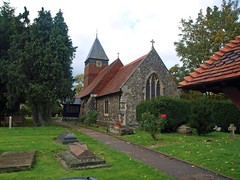ST MARY. The interest of the church is entirely its timberwork, the tower, the porch, the screen. The tower externally tile-hung with ornamental tiles, no doubt in Late Victorian days. It stands internally on six posts forming a nave and aisles. The aisles are divided horizontally by cross-beams with diagonal braces. Braces for the cross beams of the centre spring from the aisles too. The centre has beams on big braces springing from the arcade posts. Also of good timber construction is the S porch of c. 1500. It has ornate bargeboarding with tracery decoration. - SCREEN, C15, uncommonly rich. Two side openings and doorway. Each side opening is of two lights under one arch with the mullion rising up into the apex of the arch and cusped tracery. All spandrels have blank tracery panelling. - PLATE. Cup of 1650.
BULPHAN. In the flat country round the Langdon Hills, it has a few old houses and Appleton’s Farm, very attractive with its upper storey overhanging both wings of a 15th century hall. Ivy-clad elms face the green where three roads meet, an old barn on one side and a lychgate on the other. The church has a handsome timber porch of about 1500, the bargeboards elaborately carved. The building has been made new, the medieval windows and the old doorway having been reset in the wall. The walls at the west end are plastered and timbered on a brick plinth forming a square of 24 feet, and within this area stand eight oak posts placed here 500 years ago to support the bell-turret. They are joined together by cross-beams with diagonal framing above, while cross-braces add to their impressiveness. In the turret is one surviving old bell which rings out the old year and a group of five tubular bells which ring in the new.
At the other end of the nave is a 15th century screen with two bays on each side of the entrance, their heads containing bold tracery. It is a triumph of craftsmanship, and is said to have come from Barking Abbey, of which hardly a trace remains.
At the other end of the nave is a 15th century screen with two bays on each side of the entrance, their heads containing bold tracery. It is a triumph of craftsmanship, and is said to have come from Barking Abbey, of which hardly a trace remains.

No comments:
Post a Comment